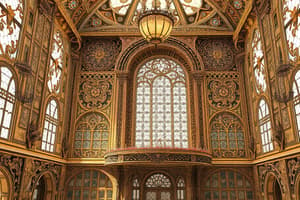Podcast
Questions and Answers
What occurs when two opposing forces are not offset and push into each other at the same point?
What occurs when two opposing forces are not offset and push into each other at the same point?
- Bending moment
- Shear stress
- Tensile stress
- Compressive stress (correct)
Which type of failure occurs when two parts of a structural member are pushed in different directions?
Which type of failure occurs when two parts of a structural member are pushed in different directions?
- Tension failure
- Compression failure
- Shear failure (correct)
- Bending failure
What defines the relationship between stress and strain up to the yield point in a material?
What defines the relationship between stress and strain up to the yield point in a material?
- Shear force
- Modulus of Elasticity (correct)
- Residual deformation
- Compressive strength
When an element is unloaded after reaching the yield point, what is observed?
When an element is unloaded after reaching the yield point, what is observed?
What is the formula for calculating stress in an element?
What is the formula for calculating stress in an element?
How are internal forces represented within a structure?
How are internal forces represented within a structure?
What is indicated when the stress reaches the maximum value in a structural element?
What is indicated when the stress reaches the maximum value in a structural element?
What characterizes the deformation of an element due to normal stress?
What characterizes the deformation of an element due to normal stress?
What is the moment of a force about a point defined as?
What is the moment of a force about a point defined as?
Under what condition can equilibrium of moments be achieved?
Under what condition can equilibrium of moments be achieved?
Which best describes co-planar forces?
Which best describes co-planar forces?
What happens to rotation if all forces are co-planar and concurrent?
What happens to rotation if all forces are co-planar and concurrent?
How can different forces be combined graphically?
How can different forces be combined graphically?
What type of forces are characterized as acting perpendicular to the cross section of an element?
What type of forces are characterized as acting perpendicular to the cross section of an element?
What is the typical sign convention for compression in elements?
What is the typical sign convention for compression in elements?
What do shear forces act along?
What do shear forces act along?
Which of the following best describes structural serviceability?
Which of the following best describes structural serviceability?
What is the relationship between weight, mass, and acceleration due to gravity?
What is the relationship between weight, mass, and acceleration due to gravity?
Which of the following factors does NOT typically shape an engineer's choice of design and materials?
Which of the following factors does NOT typically shape an engineer's choice of design and materials?
What is meant by 'statics' in the context of structural engineering?
What is meant by 'statics' in the context of structural engineering?
Which of the following is an important consideration when analyzing structures under loads?
Which of the following is an important consideration when analyzing structures under loads?
Which of these is NOT one of the basic definitions related to forces in engineering?
Which of these is NOT one of the basic definitions related to forces in engineering?
In structural analysis, the correct process following the understanding of loads involves?
In structural analysis, the correct process following the understanding of loads involves?
What is typically used to represent the direction of a force?
What is typically used to represent the direction of a force?
What is considered a permanent load that a structure needs to resist?
What is considered a permanent load that a structure needs to resist?
Which of the following best describes a structure?
Which of the following best describes a structure?
Which of the following is an example of a dynamic load?
Which of the following is an example of a dynamic load?
What is the purpose of drawing a Free Body Diagram?
What is the purpose of drawing a Free Body Diagram?
What factor differentiates live loads from static loads?
What factor differentiates live loads from static loads?
Which of the following is NOT typically an environmental action load?
Which of the following is NOT typically an environmental action load?
When engineers design structures, what is a key performance objective they must consider?
When engineers design structures, what is a key performance objective they must consider?
What type of force is a bending moment associated with?
What type of force is a bending moment associated with?
What must be true for a body to be in static equilibrium?
What must be true for a body to be in static equilibrium?
In a 2-dimensional system, which equations represent the conditions for equilibrium?
In a 2-dimensional system, which equations represent the conditions for equilibrium?
What does the equation F = m∙a signify in the context of forces?
What does the equation F = m∙a signify in the context of forces?
Which statement correctly defines a moment in this context?
Which statement correctly defines a moment in this context?
Which of the following best describes a statically determinate structure?
Which of the following best describes a statically determinate structure?
What effect does self-weight have on a structure in static equilibrium?
What effect does self-weight have on a structure in static equilibrium?
What happens to the sum of moments around a centroid in a body at rest?
What happens to the sum of moments around a centroid in a body at rest?
Which of the following represents a force causing displacement along the x direction?
Which of the following represents a force causing displacement along the x direction?
Flashcards
What is a structure?
What is a structure?
A structure is a collection of interconnected elements designed to transfer loads between points.
What is a permanent load?
What is a permanent load?
Permanent loads are always present on a structure, like its own weight.
What is a live load?
What is a live load?
Live loads are temporary loads that are not always present, like people, vehicles, or wind.
What are extreme loads?
What are extreme loads?
Signup and view all the flashcards
What is a static load?
What is a static load?
Signup and view all the flashcards
What is a dynamic load?
What is a dynamic load?
Signup and view all the flashcards
What are performance objectives for structures?
What are performance objectives for structures?
Signup and view all the flashcards
What are the performance objectives for structures?
What are the performance objectives for structures?
Signup and view all the flashcards
Structural Safety
Structural Safety
Signup and view all the flashcards
Structural Serviceability
Structural Serviceability
Signup and view all the flashcards
Force
Force
Signup and view all the flashcards
Mass
Mass
Signup and view all the flashcards
Weight
Weight
Signup and view all the flashcards
Statics
Statics
Signup and view all the flashcards
Structural Element
Structural Element
Signup and view all the flashcards
Cross-Section Area
Cross-Section Area
Signup and view all the flashcards
Moment of a force
Moment of a force
Signup and view all the flashcards
Equilibrium of Moments
Equilibrium of Moments
Signup and view all the flashcards
Co-planar forces
Co-planar forces
Signup and view all the flashcards
Concurrent forces
Concurrent forces
Signup and view all the flashcards
Non-concurrent forces
Non-concurrent forces
Signup and view all the flashcards
External forces
External forces
Signup and view all the flashcards
Normal force
Normal force
Signup and view all the flashcards
Shear force
Shear force
Signup and view all the flashcards
Static Equilibrium
Static Equilibrium
Signup and view all the flashcards
Moment
Moment
Signup and view all the flashcards
Axial Force
Axial Force
Signup and view all the flashcards
Moment Arm
Moment Arm
Signup and view all the flashcards
Statically Determinate Structure
Statically Determinate Structure
Signup and view all the flashcards
Bending Moment
Bending Moment
Signup and view all the flashcards
Stress
Stress
Signup and view all the flashcards
Strain
Strain
Signup and view all the flashcards
Modulus of Elasticity
Modulus of Elasticity
Signup and view all the flashcards
Yield Point
Yield Point
Signup and view all the flashcards
Ultimate Strength
Ultimate Strength
Signup and view all the flashcards
Ductility
Ductility
Signup and view all the flashcards
Study Notes
Structural Mechanics - Supplementary Lecture Notes (Lecture 2)
-
Key Concepts Covered:
- Understanding and applying Newton's laws
- Understanding and applying equilibrium conditions
- Drawing free body diagrams
- Familiarity with normal forces, shear forces, and bending moment
- Understanding stress and strain under normal loads
-
Suggested Reading:
- Structural Mechanics by Ray Hulse & Jack Cain - Chapter 1
What is a Structure?
-
A structure is a collection of connected elements that transfer loads from one point to another. It's not simply a collection of separate elements.
-
Examples include Tower Bridge, office buildings, Wembley Stadium, and biological structures like elephants and humans.
What Loads Do Structures Resist?
- Structures must resist their own weight, which is a permanent load.
- They also need to resist "live loads," which are temporary or variable loads caused by things like people, machinery, and vehicles.
- Other variable loads are environmental, such as wind, snow, water, waves, earthquakes, tsunamis, cyclones, flooding, and volcanic ash.
Performance Objectives for Structures
- Every structure has a specific function, such as residential, commercial, or industrial.
- Structures must meet two key performance objectives:
- Serviceability: The structure must function as intended under normal and frequent loads, meaning it should not deflect excessively or vibrate excessively.
- Safety: The structure must withstand extreme loads without collapsing.
Static Equilibrium
- Statics is the study of bodies that are not moving.
- Static equilibrium is governed by Newton's Laws.
- A body remains at rest or in uniform motion unless acted upon by a force.
- The force acting on a body is proportional to the rate of change of its momentum (impulse).
- For every action, there is an equal and opposite reaction.
Moments
-
A moment is a force multiplied by the perpendicular distance from the point of application of the force to a specified point.
-
Equilibrium of moments can be achieved when the sum of moments at a point is zero.
Forces
- Forces can be combined graphically using vector addition and trigonometry.
- Forces can be resolved into x and y components.
External Forces
- External forces act on the boundary of a structure.
- They include externally applied forces and forces applied by supports (reactions).
- External forces are categorized as normal forces, shear forces, or bending moments, based on their direction relative to the structure's cross-section.
Internal Forces
- Internal forces occur within a structure at a cut section.
- These forces are equal and opposite internally.
- Internal forces (normal, shear, and bending moment) create stresses and strains within the structure.
Stresses and Strains
- Stress is force divided by area.
- Strain is the change in length divided by the original length.
- Stress-strain diagrams illustrate the relationship between the two.
- The stress-strain diagram includes elastic and plastic regions. A material behaves elastically until it reaches its yield point; after that, the material undergoes plastic deformation with a maximum strength value called the ultimate point, followed by failure.
Studying That Suits You
Use AI to generate personalized quizzes and flashcards to suit your learning preferences.




